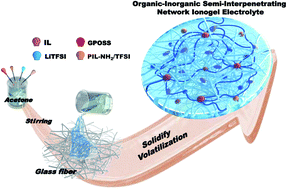An organic–inorganic semi-interpenetrating network ionogel electrolyte for high-voltage lithium metal batteries†
Abstract
Lithium metal batteries are promising next generation energy storage devices. However, uncontrolled lithium dendrite growth and inevitable side reactions of traditional organic liquid electrolytes with electrodes are obstacles to their practical applications. Herein, a new ionogel electrolyte with an organic–inorganic semi-interpenetrating network is designed by the confinement of ionic liquid within a NH2 pendent group optimized cross-linked poly(ionic liquid) copolymer backbone and glass fiber scaffold. The ionogel electrolyte shows superior physicochemical properties, including improved lithium ion transmission, high mechanical strength, wide electrochemical window, non-leakage, non-volatility and fire resistance. In Li//Li symmetric cells fabricated with this ionogel electrolyte, repeated Li plating/stripping could last over 1800 h without significant dendrite formation. Besides, the full cells paired with a high-voltage Li3V2(PO4)3 cathode present excellent cycling stability with a capacity retention of 83% after 1000 cycles (0.5C rate, 3.0–4.3 V) and 91% after 100 cycles (0.2C rate, 3.0–4.8 V). This study presents a new strategy for the use of organic–inorganic semi-interpenetrating networks for designing new composite ionogel electrolytes with desirable properties for high-voltage LMBs.



 Please wait while we load your content...
Please wait while we load your content...